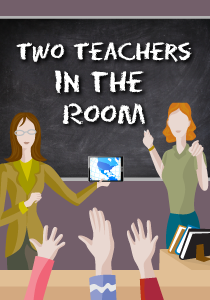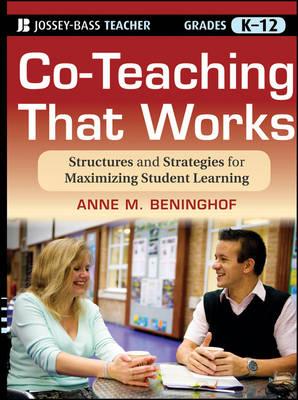Anne Beninghof Talks about Great Co-Teaching
A MiddleWeb Blog

Anne agreed to an interview for our Two Teacher blog, and I’m delighted to have you see for yourself what a dynamic speaker and innovative educator she is.
Some background: Anne is considered a pioneer in the area of inclusion and has published six books on teaching diverse learners in inclusion classrooms. She is a professional development consultant who firmly connects her ideas to research and real-world experience. Anne has a practical, solution-seeking mindset that she’s able to bring to bear on any educator’s situation, with the ultimate goal of achieving success for all students. Amid her workshops and keynotes, she maintains a part-time teaching position to stay strongly connected to the realities of today’s classrooms. For more information about Anne, check out her website. OK, enough from me…let’s hear from Anne.
Elizabeth: Please tell us about your teaching career and how you became so passionately involved in supporting teachers and reaching students with special needs.
Anne: My first teaching years were spent in schools that served only children with disabilities. While the purpose for segregating these students was sometimes noble – more specialized facilities, and access to more intensive health care – my experiences led me to believe that the negative outcomes surpassed the positive possibilities.
Segregated programs led to lower expectations and standards for both students and staff. Time after time I saw that views about learning were skewed and that services to the most needy were not given priority. After several frustrating years, I realized that the vast majority of children with disabilities would be best served in the same settings as their non-disabled peers.
Elizabeth: Through your writing and presentations, you share such valuable, practical advice about how to make co-teaching work in real-world classrooms. Please share some of your own co-teaching experiences.
Anne: I am truly fortunate to have been able to co-teach with a number of gifted classroom teachers. From each partner I have learned new things – from absorbing their curriculum expertise, to picking up tricks for classroom management.
One example: I was co-teaching with Lora, a veteran teacher, who uses a simple strategy when a student gives what appeared to be an incorrect answer to a question. She says, “Tell me more about your thinking.” I frequently noticed that the student was able to explain his thinking in a way that showed he really was on the right track. I decided right then and there to incorporate that little phrase into my own interactions with students. What excites me most is that I can take this kind of new learning with me and share it with my next co-teaching partner and our students.

Anne: Most educators are very professional and place the needs of students first. Occasionally we encounter a teacher who is reluctant to co-teach. (I prefer the term “reluctant” to resistant because it feels more hopeful!) A first step is to determine what is at the root of the reluctance. Thoughtful, non-threatening questioning can gather helpful information. For example, as a special educator or facilitator I might ask, “What do you think is making it difficult for your co-teaching to move forward?” Just recently I used this question as a probe and the classroom teacher blurted out, “I’m a control freak!” Once this admission was out in the open, it was easier to develop strategies to help the team take some steps to improve.
Elizabeth: The ultimate goal for an inclusion classroom is to allow all students to access the general education curriculum in ways that result in meaningful learning. What are your thoughts regarding balancing the learning and individual needs with the higher expectations that all students are required to achieve?
Anne: Special education is defined as “specially designed instruction” to meet the needs of a student with a disability. As partners analyze standards and design responsive instruction, we often see that the ideas generated benefit many other students in the class. For example, the partners may decide that using a skill groups model for the lesson will be most effective. They divide the class into three groups – one that needs support, one that is on grade level, and one that is ready for more. Learning and practice activities are developed that fit each group’s unique needs. In a lesson on area of a circle, for example, one group may learn the formula, practice it using wikki stix as manipulatives, and work on memorization strategies. Another group might learn the formula, practice it and develop real-world applications. A third group might learn the formula and explore the question, “How is the area of a circle related to the area of a rectangle?”
Elizabeth: How do you think we can make the benefits of co-teaching attainable for more co-teaching situations at the elementary and secondary levels?

Thanks, Anne!
As for our readers…I will leave you with one of my many favorite quotes by Anne Beninghof:
“Co-Teaching isn’t taking turns; it’s teaching together.”
In addition to commenting here, I encourage you to learn more about Anne and what she is up to by visiting Ideas for Educators. At her site you’ll also find downloadables that you can apply in your classrooms tomorrow.
Enjoy!




































Myself and some other special education advocates attended a recent conferences like this and we really learned a lot.
Sean, thanks for sharing your connection–what was one strategy you learned that you want to make sure to include as you plan for the upcoming school year?